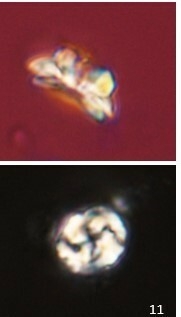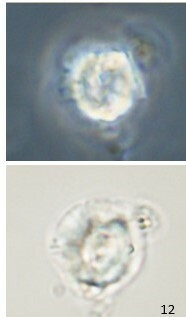Asinithistimorfi aubryae
Set number: 47
-
1
-
2
-
3
-
4
-
5
-
6
-
7
-
8
-
9
-
10
-
11
-
12
-
13
-
14
-
15
-
16
-
17
-
18
-
19
-
20
-
21
-
22
-
23
-
24
-
25
-
26
-
27
-
28
-
29
-
30
-
31
-
32
10µm
Asinithistimorfi paraxenos Bowman & Varol, 2021
Elliptical heliolith possessing two non-birefringent discs and a moderate-high column that appears hollow and closed by a distal plug. The diameter of the median disc is greater than the diameter of the proximal disc.
In honour of renowned nannofossil specialist Dr M.-P. Aubry, seasoned nannofossil taxonomist and biostratigrapher.
Overall height: 4.21μm, Overall length: 8.33μm, Overall width: 4.21μm; Column height:1.93μm, Column length: 6.27μm, Column width: 5.44μm.
Moderately large (6.0-9.0 µm) and elliptical heliolith comprised two discs and a column. The discs are of unequal diameter (i.e. the median disc is wider than the proximal disc) and appear flat to very slightly convex (observed in side-view). The distal plug appears rough and distinct. The discs and narrow central opening are visible under phase-contrast and bright-field settings (Plate 2, Figs. 20 and 24 in Bowman & Varol, 2021) in plan-view. The column and plug artificially resemble an overgrown Dictyococcites bisectus under polarised light.
Optical properties: In plan-view, the discs are non-birefringent, and the column is strongly birefringent. The entire species appears birefringent in the side-view. In cross-polarised light, the distal side shows a dextrogyre-type extinction pattern (e.g. Pl. 3, Figs. 10, 14 in Bowman & Varol, 2021). In contrast, the proximal side is characterised by a laevogyre-type extinction pattern (e.g. Pl. 3, Figs. 11, 15 in Bowman & Varol, 2021). When using the gypsum plate, with the species oriented in the north-south position, a distal view will show the blue regions corresponding to the horizontal axis. In contrast, a proximal view will show the blue sectors corresponding to the vertical axis.
The elliptical shape and bizarre rough appearance of the column and plug (and unique form of species in general) are diagnostic identification features.
Bowman, A. R. & Varol, O. 2021. A Taxonomic Revision of Heliolithaceae - Applications in Resolving the Problematic Calcareous Nannofossil Biostratigraphy of the Paleocene. In: M. Montenary, M. (Ed.). Calcareous nannofossil biostratigraphy of the Stratigraphy and timescales. 6: 43-223.

